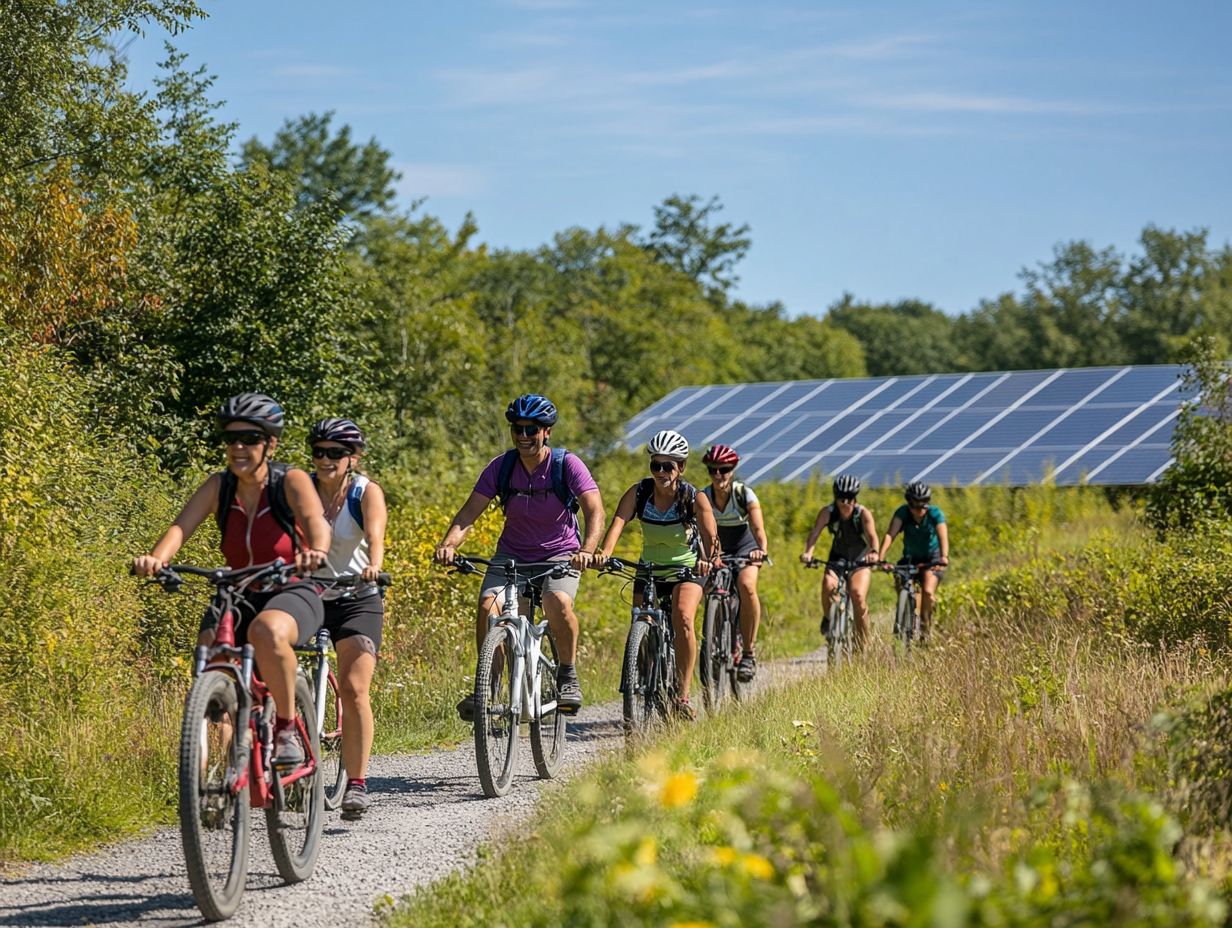5 Ways to Reduce Your Carbon Footprint on Trips
Traveling can be a delightful adventure, but it often carries a hefty environmental price tag. As you embark on your journeys, it’s exciting to recognize the positive impact you can make by being mindful of the carbon footprint you leave behind, which can adversely affect our planet.
This piece outlines five practical strategies for minimizing your impact while traveling. Each choice you make from selecting eco-friendly accommodations to supporting local businesses can foster a more sustainable future.
This piece covers the wider implications of travel on the environment and how you can contribute to positive change. Discover the art of traveling smarter and greener!
Contents
- Key Takeaways:
- 1. Choose Eco-Friendly Accommodations
- 2. Use Public Transportation or Walk
- 3. Pack Light and Use Sustainable Products
- 4. Support Local Businesses and Sustainable Practices
- 5. Educate Yourself and Others on Sustainable Travel
- Why Is Reducing Your Carbon Footprint Important?
- What Are the Negative Effects of Travel on the Environment?
- How Can Sustainable Travel Benefit Local Communities?
- What Are Some Other Ways to Reduce Your Carbon Footprint While Traveling and Support Sustainable Practices?
- How Can You Offset Your Carbon Emissions While Traveling?
- What Are Some Sustainable Travel Destinations to Consider?
- Frequently Asked Questions
- What does it mean to reduce your carbon footprint on trips?
- What are 5 ways to reduce your carbon footprint on trips?
- How can using public transportation reduce your carbon footprint on trips?
- Why is it important to pack light when trying to reduce your carbon footprint on trips?
- How can staying in eco-friendly accommodations help reduce your carbon footprint on trips?
- What are carbon offset credits and how can they help reduce your carbon footprint on trips?
Key Takeaways:

- Choose eco-friendly accommodations to reduce your carbon footprint.
- Utilize public transportation or walk whenever possible to minimize your impact.
- Pack light and use sustainable products to decrease your carbon emissions while traveling.
1. Choose Eco-Friendly Accommodations
Choosing eco-friendly accommodations is a crucial step in your journey toward sustainable travel. Not only does it significantly reduce your carbon footprint, but it also enriches your travel experience with local cuisine and energy-efficient amenities.
By opting for hotels that prioritize sustainability, you support reforestation efforts, plant trees, and community initiatives, aligning your travel choices with climate-conscious practices. Cities like Paris and Barcelona offer a plethora of eco-friendly hotels that embody these values, ensuring your stay contributes to the restoration of ecosystems rather than their degradation. Additionally, consider the 5 ways to support eco-friendly tourism to further enhance your travel experience.
Take Paris, for example. Hotels like the Hôtel de Sers embrace green practices, utilizing solar energy and robust recycling programs. When you find yourself in Barcelona, the Eco Grand Hotel awaits, sourcing its ingredients from local markets. You can indulge in authentic Catalan dishes while championing sustainable agriculture. For more tips on how to make eco-conscious choices while traveling, check out Travel Smart: Tips for Eco-Friendly Decisions. Dining at these hotels allows you to savor the rich flavors of regional cuisines while actively supporting local farmers and businesses.
This holistic approach not only deepens your cultural appreciation but also plays a vital role in preserving the environment and bolstering local economies.
2. Use Public Transportation or Walk
Utilizing public transportation or choosing to walk during your travels can significantly reduce your travel emissions, making it a savvy choice for sustainable travel and an impactful way to lower your carbon footprint.
Choose these environmentally friendly options to cut down on pollution and enrich your travel experience as you meander through the vibrant streets of cities like Ljubljana or the breathtaking landscapes of Costa Rica. By opting for local buses or leisurely strolls through charming neighborhoods, you immerse yourself in the local culture, uncover hidden gems, and engage in authentic interactions with residents. Additionally, learn how to make your next trip more eco-friendly for an even greater impact.
Supporting public transport systems also bolsters local economies. As more travelers embrace these services, the revenue generated can be reinvested into community projects. Beyond the economic perks, these choices are essential in the fight against climate change, fostering a healthier urban environment that future generations will cherish.
3. Pack Light and Use Sustainable Products
Packing light and opting for sustainable products are key strategies for reducing your carbon footprint and minimizing travel emissions, amplifying your commitment to eco-friendly travel.
By being mindful of your luggage weight, you can significantly lower your overall environmental impact. Heavier bags demand more fuel for transportation. Incorporating items like reusable water bottles and biodegradable toiletries into your packing list not only cuts down on waste but also helps reduce plastic use when traveling and minimize single-use plastics.
Every thoughtful choice you make, whether it’s selecting environmentally-friendly fabrics or opting for ethical brands, contributes to a more sustainable travel experience. Embracing these climate-conscious decisions before you embark on your adventure sets a positive tone and inspires those around you to consider the ecological footprint of their own journeys. For instance, following the best practices for sustainable road trips can make a significant difference.
4. Support Local Businesses and Sustainable Practices

Supporting local businesses and sustainable practices is a cornerstone of sustainable tourism. It enhances your travel experience while providing essential support to communities.
By engaging with local markets and restaurants, you gain unique insights into the culture and traditions of a region. You can savor authentic dishes crafted from locally sourced ingredients. In destinations like Palau, where sustainable fishing practices are celebrated in local cuisine, you indulge in delightful meals and help preserve delicate ecosystems.
Similarly, Slovenia s dedication to supporting local farmers and artisanal producers ensures you enjoy the rich flavors of the land while contributing to the livelihoods of its residents. By choosing to eat and shop locally, you create a positive ripple effect that strengthens both communities and economies.
5. Educate Yourself and Others on Sustainable Travel
Educating yourself and others about sustainable travel practices is essential for addressing climate change. Initiatives like the T.R.E.E.S. School Program help foster community support.
Engage with a variety of resources such as online courses, workshops, and local meetups. These will give you invaluable insights into eco-friendly tourism. You can make informed choices and inspire your family and friends with your newfound knowledge.
When more people learn this information, it sparks a movement toward better environmental choices. Your participation in global campaigns today can inspire others and create a wave of positive change.
Why Is Reducing Your Carbon Footprint Important?
Reducing your carbon footprint is essential for tackling the climate crisis. Even the smallest changes you make can yield significant benefits for the planet.
By engaging in eco-friendly practices, you drastically lower harmful emissions and champion sustainability. This collective effort mitigates the effects of climate change and enhances the well-being of communities around you.
Supporting carbon offset programs is crucial. These programs compensate for carbon emissions by funding projects that plant trees or create renewable energy. Every contribution aids in restoring damaged ecosystems and boosting biodiversity.
Your individual commitments can create meaningful impact, fostering a healthier planet for future generations.
What Are the Negative Effects of Travel on the Environment?
Travel can significantly impact the environment, primarily through high travel emissions and an inflated carbon footprint that exacerbate the climate crisis.
However, the consequences extend beyond emissions. The flourishing tourism industry often leads to increased pollution, overwhelming local ecosystems with waste. This influx can wreak havoc on delicate habitats as natural areas are transformed to accommodate tourist facilities.
Resource depletion becomes pressing as destinations struggle to sustain their water, energy, and food supplies. Recognizing these impacts is essential for you as a traveler. By following 7 tips for eco-friendly road trips, you can adopt sustainable practices that safeguard the environment and preserve the beauty of destinations for generations to come.
How Can Sustainable Travel Benefit Local Communities?

Sustainable travel can significantly enhance local communities by promoting responsible tourism and supporting neighborhood businesses. It also encourages the preservation of local cuisine and culture.
This approach builds a deeper sense of community identity and opens doors to many job opportunities in fields like eco-tourism which focuses on responsible travel to natural areas hospitality, and artisanal crafts. Take Costa Rica and Bhutan, for example; both destinations have skillfully integrated eco-friendly practices into their tourism frameworks, leading to increased employment and greater economic resilience.
In Costa Rica, community-driven conservation initiatives have enabled local farmers and artisans to offer travelers authentic cultural experiences. Bhutan s commitment to sustainable tourism has preserved its rich heritage while reinforcing its economy by inviting visitors to interact respectfully with local customs and communities.
What Are Some Other Ways to Reduce Your Carbon Footprint While Traveling and Support Sustainable Practices?
You have many effective strategies at your fingertips to reduce your carbon footprint while traveling. Opting for eco-friendly choices and adopting sustainable practices can make a significant difference.
First, consider selecting direct flights. They can dramatically cut down greenhouse gas emissions compared to flights with layovers. Additionally, explore top sustainable travel practices to follow, including carbon offset programs, which let you financially support projects designed to reduce carbon emissions. It’s like giving Mother Earth a little thank-you gift!
Once you arrive at your destination, mind local transportation options like public transit or cycling. These choices lessen your impact on the planet and enrich your travel experience with a touch of authenticity.
Bring along reusable bags and water bottles to cut down on plastic use. This small change can have a meaningful impact on environmental conservation.
By making these thoughtful choices, you can actively contribute to a healthier planet and feel good about it!
How Can You Offset Your Carbon Emissions While Traveling?
Offsetting your carbon emissions can be achieved through methods like purchasing carbon offsets that support reforestation efforts and other green initiatives.
By investing in these offsets, you contribute to projects that absorb carbon dioxide, promote biodiversity, and uplift local communities. To further enhance your travel experience, consider checking out how to stay green while traveling abroad. For example, organizations like One Tree Planted focus on planting trees worldwide, transforming each offset purchase into tangible environmental benefits.
Choosing reputable carbon offset programs is essential. Poorly managed initiatives can lead to minimal impact and undermine the global fight against climate change. To learn more about this, check out how to offset your carbon footprint when traveling. Prioritizing credible organizations ensures that every dollar you spend genuinely enhances sustainability.
What Are Some Sustainable Travel Destinations to Consider?
When you think about sustainable travel, certain destinations truly stand out for their commitment to eco-friendly options and community support. They are perfect for environmentally conscious explorers like yourself.
Take Costa Rica, for instance. It shines with its extensive national parks and dedication to preserving biodiversity. Here, local communities engage in conservation programs, allowing you to immerse yourself in authentic rural life while supporting ecotourism. For those looking to explore sustainably, consider these budget-friendly tips for eco-friendly travel.
Then there’s Palau, which has garnered attention for its rigorous marine protection initiatives. These efforts ensure the health of its unique coral reefs while involving indigenous populations in sustainable fishing practices.
Both of these locations exemplify how responsible tourism beautifully intertwines with natural splendor and vibrant local cultures. You can explore while leaving a positive mark on the world!
Join the movement for sustainable travel today!
Frequently Asked Questions

What does it mean to reduce your carbon footprint on trips?
Reducing your carbon footprint on trips means taking actions to decrease the amount of harmful gases created during your travels. This includes using more sustainable transportation methods and making conscious choices to minimize your impact on the environment.
What are 5 ways to reduce your carbon footprint on trips?
- Choose sustainable transportation: Use public transport, bike, or walk.
- Pack light: Carrying less weight saves fuel.
- Stay eco-friendly: Look for accommodations committed to sustainability.
- Support local businesses: This reduces transportation emissions.
- Offset emissions: Buy carbon credits to balance your footprint.
How can using public transportation reduce your carbon footprint on trips?
Using public transportation reduces your carbon footprint by decreasing the number of individual vehicles on the road. This lowers the harmful gases released into the atmosphere and helps reduce air pollution.
Why is it important to pack light when trying to reduce your carbon footprint on trips?
Packing light reduces your vehicle’s weight, which in turn lowers the amount of fuel it consumes. This minimizes the harmful gases released into the atmosphere and helps lower your overall carbon footprint.
How can staying in eco-friendly accommodations help reduce your carbon footprint on trips?
Eco-friendly accommodations use sustainable practices like renewable energy, waste reduction, and water conservation. By staying in these types of places, you support businesses that actively work to minimize their impact on the environment.
What are carbon offset credits and how can they help reduce your carbon footprint on trips?
Carbon offset credits allow you to compensate for the harmful gases produced during your trip. You can purchase these credits, which fund projects that reduce carbon emissions, such as renewable energy initiatives or reforestation efforts. This is a great way to counteract your travel impact and help the planet!






